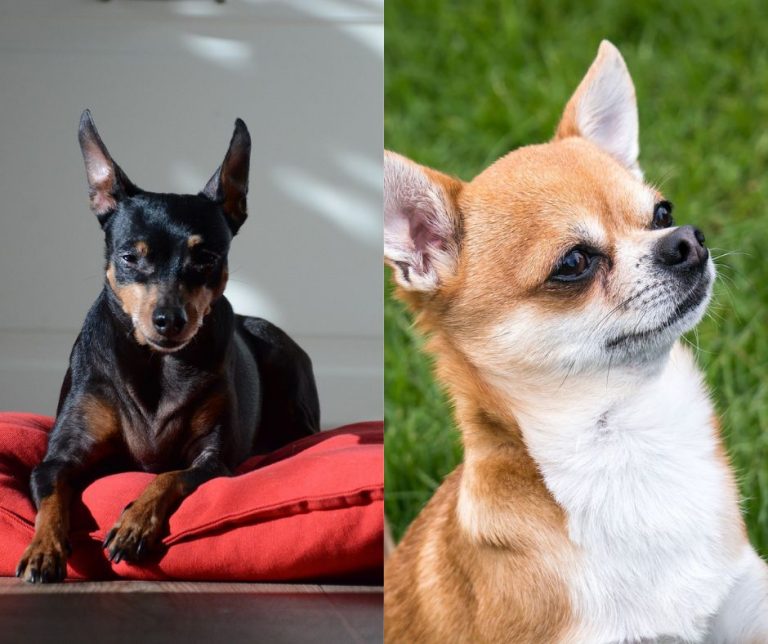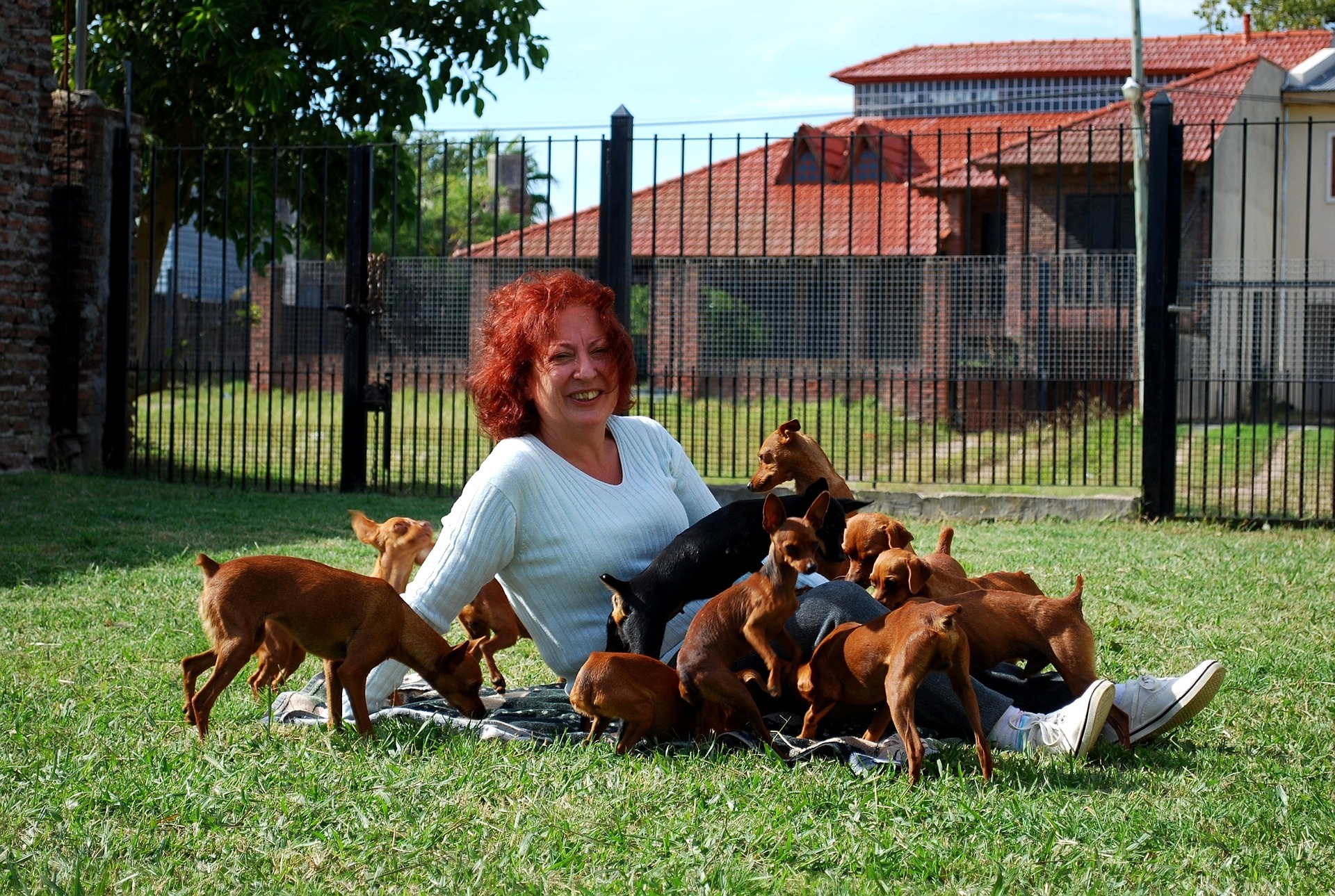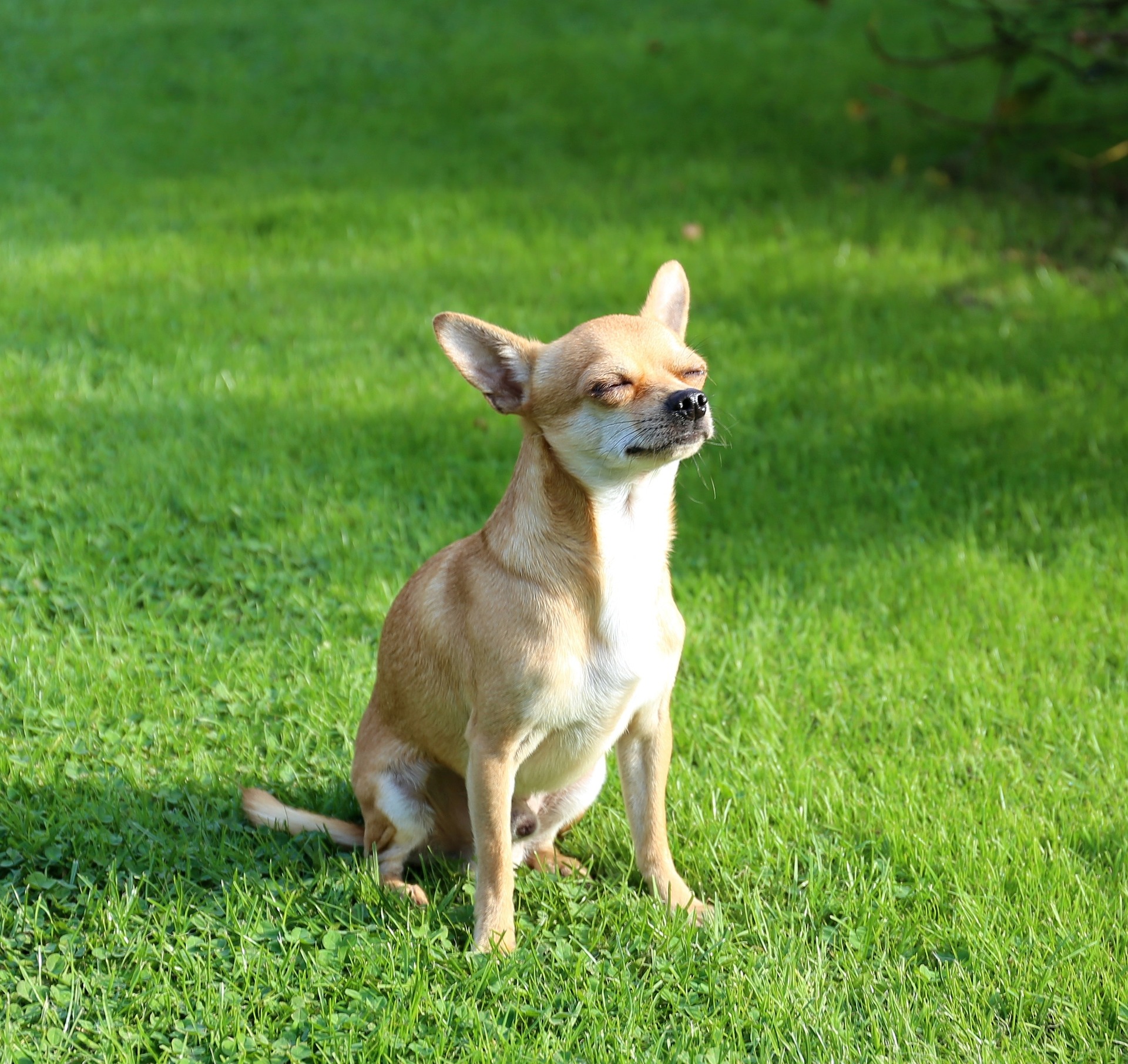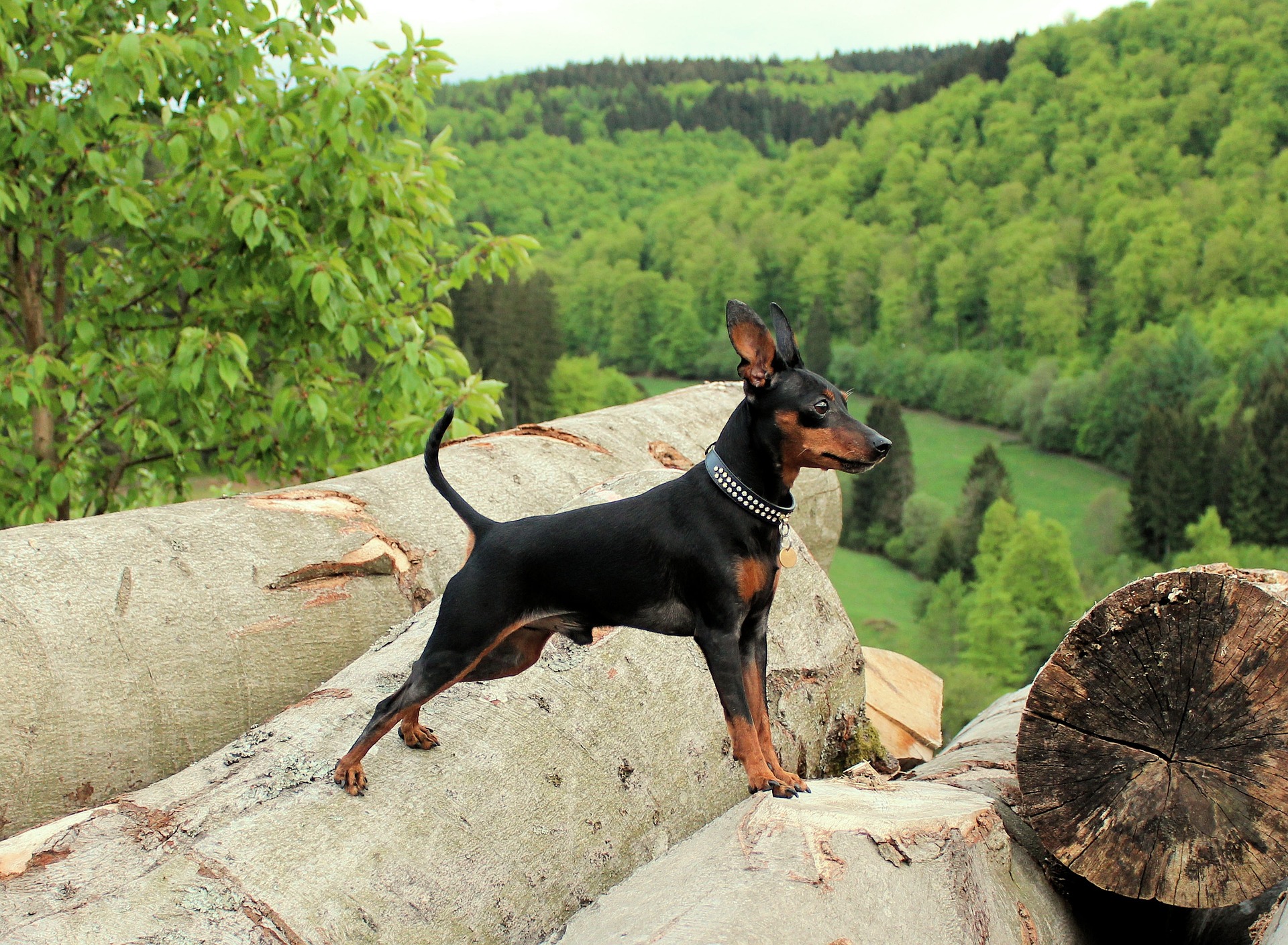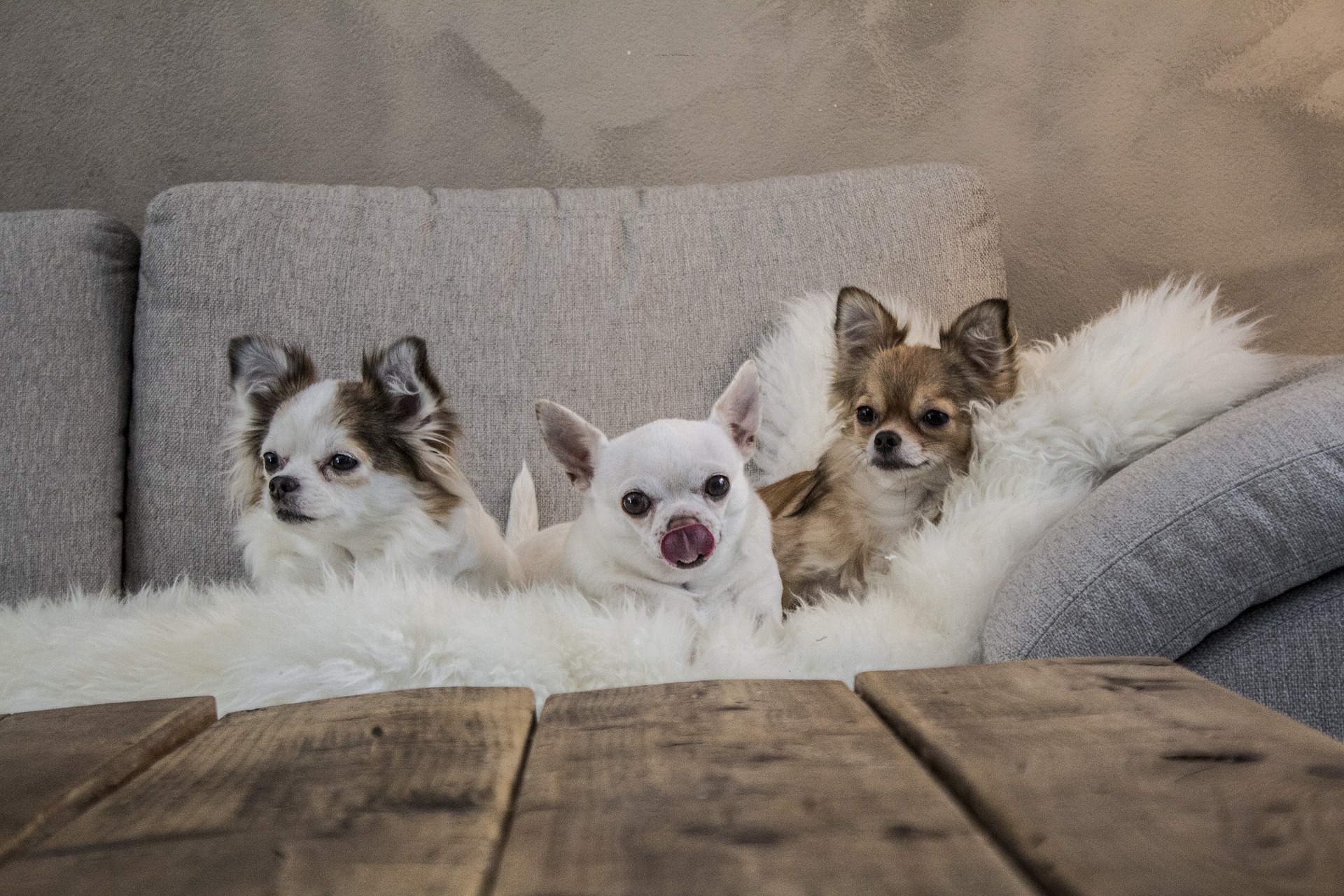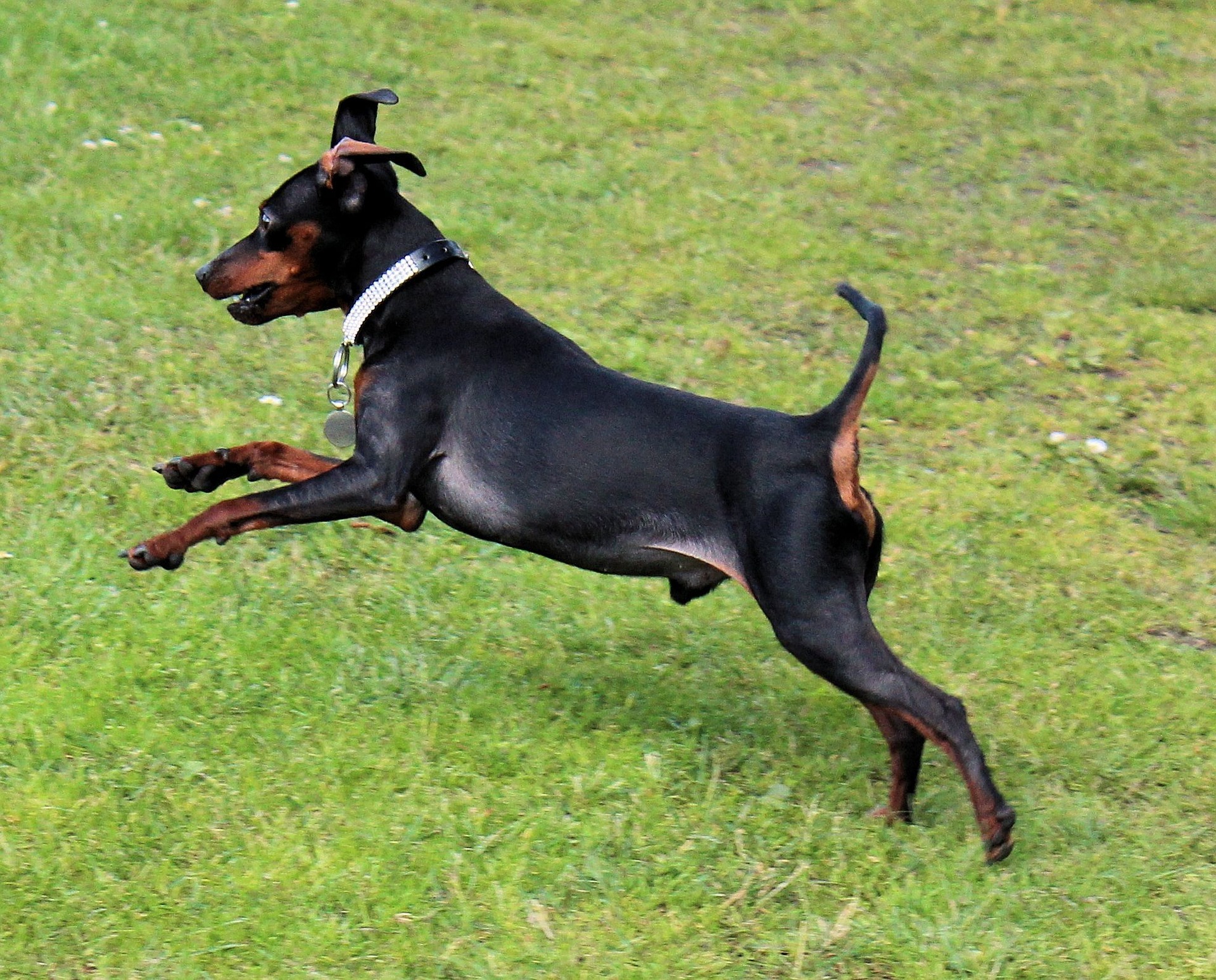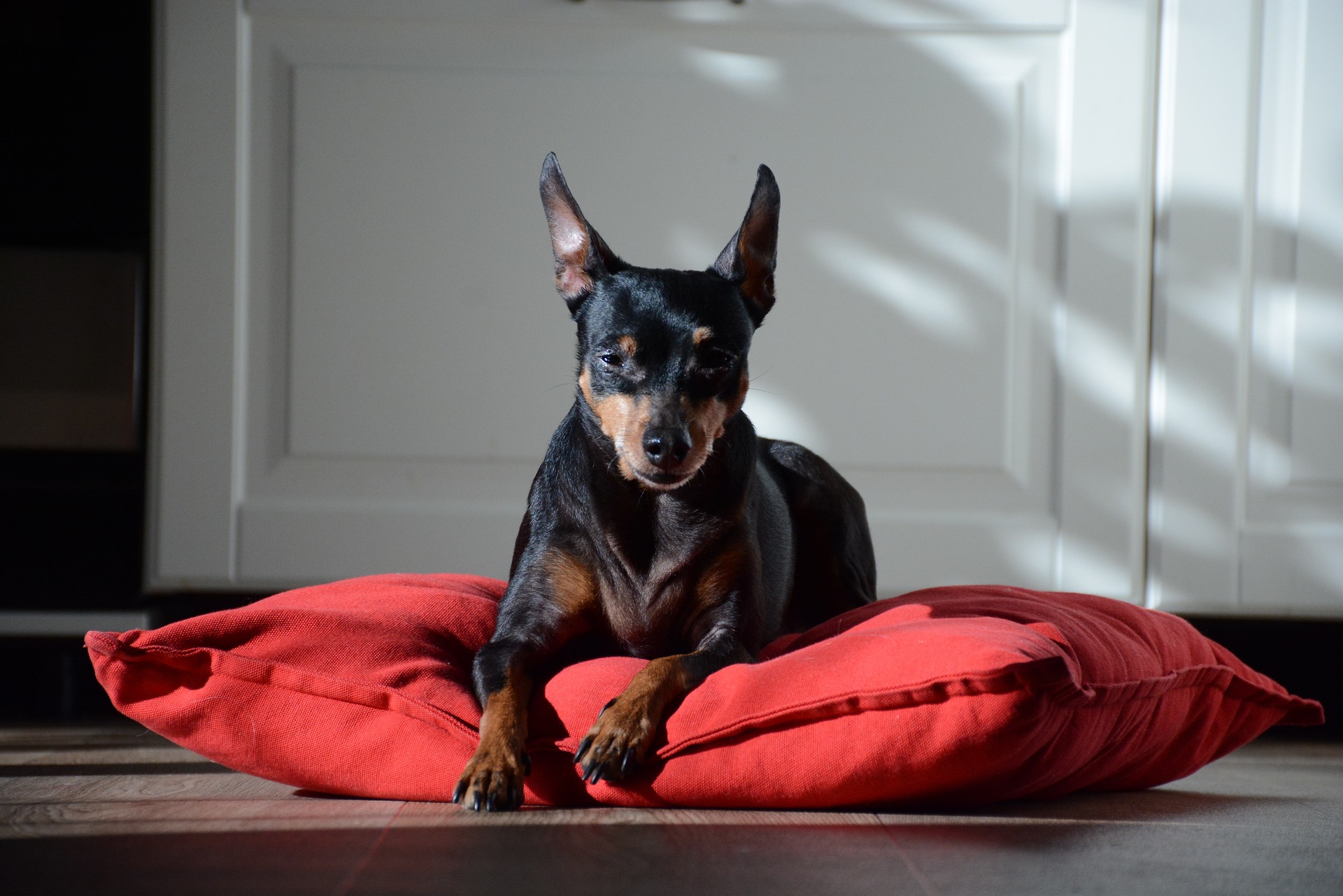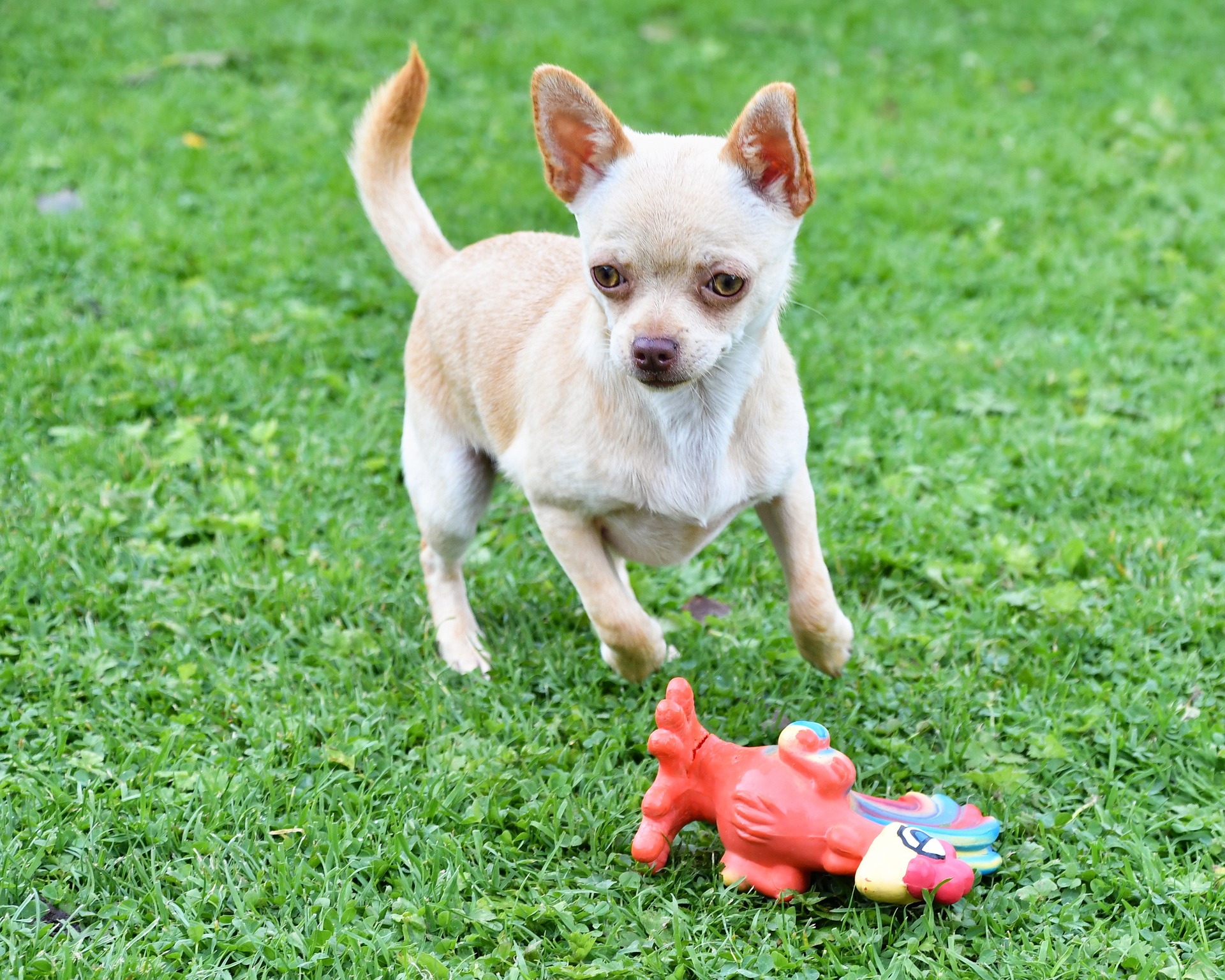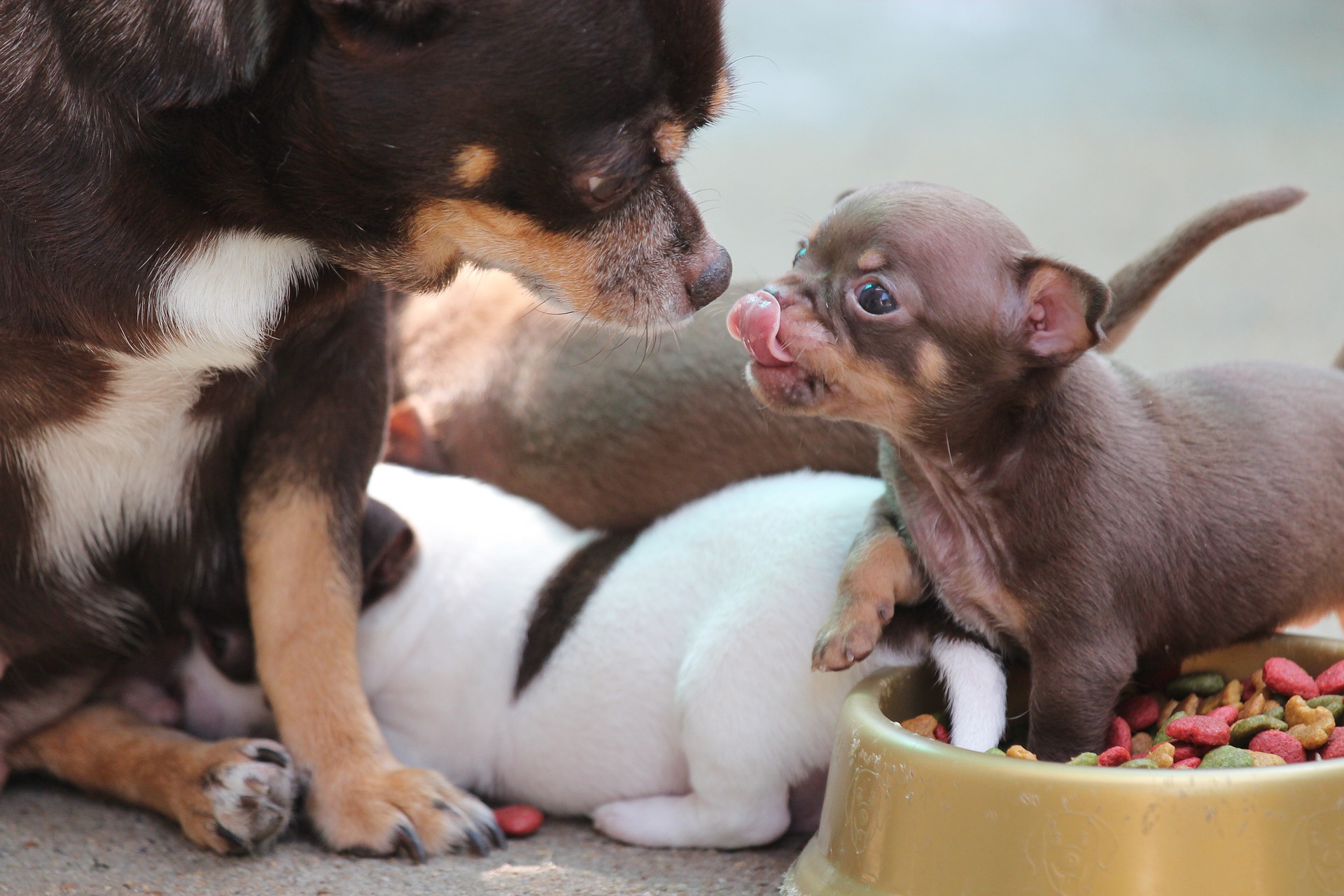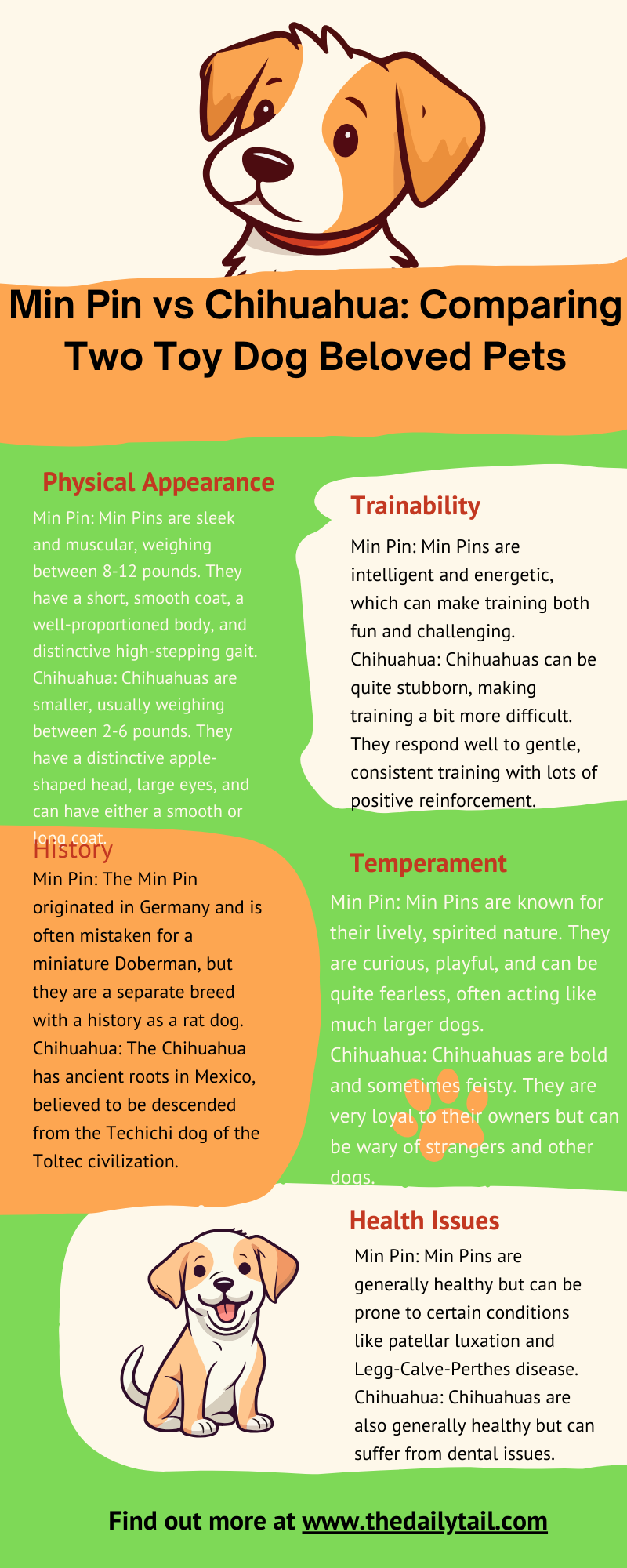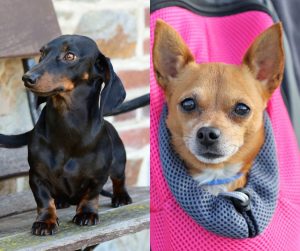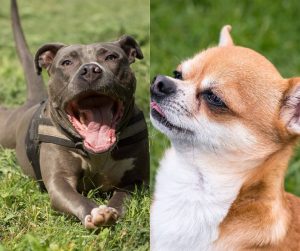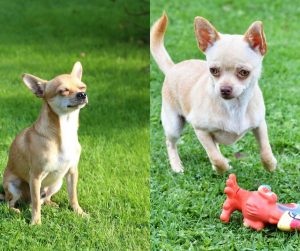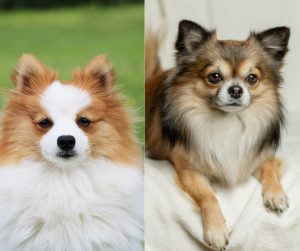When comparing the Chihuahua and the Miniature Pinscher, affectionately known as the Min Pin, potential pet owners are often charmed by their small size and dynamic personalities.
Despite their toy breed classification and similar statures, these two breeds exhibit distinct differences in temperament, physical characteristics, and care requirements.
The Chihuahua, believed to originate from ancient Mexico, typically presents a strong-willed and vivacious character. On the other hand, the Miniature Pinscher, with its ancestry tied to Germany and often mistaken as a mini Doberman, displays a confident and assertive nature.
Understanding these breeds’ unique traits is crucial when deciding which furry companion to welcome into one’s life.
Chihuahuas and Min Pins both demand attention and plenty of love, yet their maintenance needs vary.
Chihuahuas require less exercise but can be feistier, while Min Pins are known for their high energy and escapist tendencies—requiring secure living spaces to thwart their adventurous spirits.
Their differences extend to health and lifespan, where Chihuahuas are known to potentially enjoy longer lives than Min Pins, emphasizing the importance of considering long-term care. While they are similar size, there are plenty of differences between these two. So, let’s take a look at the Min Pin vs Chihuahua dog breed comparison.
Key Takeaways
- Chihuahuas and Min Pins have unique characteristics that appeal to different lifestyles
- Awareness of each breed’s health needs ensures well-informed, long-term care decisions
- Understanding a breed’s personality and exercise requirements can enhance the bond between pet and owner
Breed Origins
In the colorful tapestry of dog breed histories, the Chihuahua and the Miniature Pinscher stand out for their unique and rich origins that trace back to Mexico and Germany, respectively. These backstories not only enrich their character but also explain some of their distinctive traits.
History of the Chihuahua
The Chihuahua, recognized for its petite stature and spirited personality, boasts an origin story steeped in mystery and national pride.
It is widely accepted that Chihuahuas originated in Mexico, with some thinking they descended from the Techichi, a small canine favored by the Toltec civilization in ancient Mexico.
While they are firmly associated with Mexican culture, theories suggest these tiny dogs may have roots that span back to Malta or even China. Regardless, their association with Mexico is strong, and they’re often considered the country’s national dog.
History of the Miniature Pinscher
Contrary to a common misconception, the Miniature Pinscher is not a ‘miniature Doberman’ but a distinct breed with its own storied history.
Originating from Germany, the Miniature Pinscher, affectionately known as the “Min Pin,” was bred primarily to hunt rats in homes and stables. They share a history of being a proud and confident companion.
Despite the similar physical attributes that lead to comparison with the Doberman, their breeding lines and purposes were quite unrelated. The Min Pin’s history is rich with stories of their feisty determination and bold character, owing to their role as an efficient vermin hunter.
Physical Characteristics
When considering a new furry friend, one tends to notice their physical attributes first. Both the Miniature Pinscher and the Chihuahua have distinct appearances that set them apart not just from one another but also from other breeds. They each carry a unique charm in their stature and coloration, making them easily recognizable. Do you want to know is your dog a Min Pin or a Chihuahua? Let’s find out the physical differences in our Min Pin vs Chihuahua breed comparison.
Size and Weight
The Miniature Pinscher puppy is a compact, small dog breed whose weight ranges from 8 to 10 pounds. They typically stand tall at about 10 to 12.5 inches at the shoulder. Despite their small size, they carry themselves with a sturdy, robust presence.
In contrast, a Chihuahua typically weighs in slightly lighter between 3 to 6 pounds and stands proudly albeit slightly shorter with a height of 5 to 8 inches at the shoulder. Their petite frame is one of their most notable traits, often making them the preferred lap dog. Chihuahuas can also vary in shape and coat length. But both Apple Head and Deer Head Chihuahua dogs are available in short coat or long coat.
Coat and Colors
Miniature Pinscher:
- Coat Type: Sleek, short, and smooth to the touch, their fur is low-maintenance
- Colors: They don various shades, including solid red, stag-red (red with black hairs), black and rust, and chocolate and rust
Chihuahua:
- Coat Type: Chihuahua dogs showcase two coat varieties: the smooth and short coat and the long, soft fur that may require a bit more grooming
- Colors: They boast a broad palette, from solid colors like black, white, fawn, and chocolate to mixed patterns with various markings
Both breeds possess a vivacious spirit which is often reflected in their sparkling, attentive eyes and perky ears, heightening their expressive appearance. The Min Pin’s sleek coat and the Chihuahua’s potentially feathery fur add to their individualistic appeal.
Min Pin vs Chihuahua Temperament and Personality
When choosing between a Chihuahua and a Miniature Pinscher, understanding their temperaments and personalities is essential. Both breeds are known for their distinct characters and energy levels, but they showcase this in unique ways. Let’s get up close and personal with what makes each of these pint-sized pups special in their own right.
Chihuahua Disposition
Chihuahuas tend to have a personality that is larger than their tiny statures would suggest. They’re often:
- Energetic and feisty, thriving in environments where they can be the center of attention
- Known for their loyalty to their owners, which can sometimes translate into a protective behavior
Chihuahuas can be quite outgoing, but they might also have a bit of a stubborn streak. Their behavior can be affectionate and charming, although they may be reserved around strangers.
Miniature Pinscher Temperament
Miniature Pinschers, affectionately known as “Min Pins,” display:
- A confident persona, often described as fearless despite their small size
- An energetic and spirited presence, with a natural curiosity that keeps them alert
They are also very lively and outgoing, with a bit of a mischievous side to their personality. Min Pins can be very loyal to their family, a trait that makes them good watchdogs. However, they can exhibit stubbornness, especially if not given consistent and firm training.
Health and Care
When it comes to the health and care of Miniature Pinschers and Chihuahuas, owners should be mindful of certain breed-specific health issues and understand the grooming and maintenance requirements to ensure their pets lead happy, healthy lives.
Common Health Issues
Both Miniature Pinschers and Chihuahuas can be predisposed to specific health problems that potential owners should consider:
- Patellar Luxation: This condition, where the kneecap dislocates from its normal position, can affect both breeds
- Heart Murmurs: Often indicative of underlying heart problems, murmurs are not uncommon in these small dog breeds
- Progressive Retinal Atrophy (PRA): This eye condition can lead to blindness and may affect both breeds
- Hypothyroidism and Epilepsy: These are potential health concerns, with hypothyroidism affecting metabolism and epilepsy causing seizures
- Collapsed Trachea and Hypoglycemia: More common in Chihuahuas, these conditions require careful monitoring
- Shivering: Both breeds are known to shiver, which can be a sign of cold, excitement, or stress, but may also indicate health issues
- Obesity: Small breeds can easily become overweight, affecting their overall health
- Dental Problems: Due to their small mouths, both breeds could develop dental issues without proper care
Grooming and Maintenance
Grooming needs for both breeds are distinct and important for their health:
- Grooming Needs:
- Miniature Pinschers have short, smooth coats that require minimal grooming
- Chihuahua dogs come in both short and long coats, with long-coated Chihuahuas needing regular brushing to prevent tangles
- Maintenance:
- Both dog breeds need regular dental check-ups and teeth cleaning to prevent dental problems
- Nails should be trimmed regularly to prevent overgrowth and splitting
- Regular check-ups with the vet are essential to keep an eye on potential health issues early on
Training and Socialization
When considering a Chihuahua or Miniature Pinscher, it’s important to understand their unique training and socialization requirements.
Both breeds are intelligent and capable but require a patient and consistent approach to training. They’ll thrive on positive reinforcement and benefit greatly from early socialization to develop into well-rounded pets.
Min Pin vs Chihuahua Trainability
The Chihuahua is a small breed often known for its sassy personality and intelligence.
They can be trained successfully, but trainers need to be patient and gentle due to their sensitive nature.
Using positive reinforcement techniques, such as treats and praise, works best with Chihuahuas, as they may shut down or become stubborn if treated harshly.
They do have a moderate energy level, so short and fun training sessions will keep them engaged without causing undue stress.
On the other hand, the Miniature Pinscher, often referred to as the “King of Toys,” is an energetic and assertive breed.
They possess a high energy level which should be channeled into constructive training sessions. They’re also highly intelligent, so they pick up on training quickly but may develop separation anxiety if left alone for too long.
Keeping sessions short, consistent, and full of positive reinforcements will ensure they stay interested in learning. This breed may not be as suitable for first-time dog owners due to their spirited nature.
Social Behavior
Socialization is critical for both Chihuahuas and Miniature Pinschers to foster confidence and good behavior around other animals and people.
Chihuahuas often bond closely with their families and can be reserved around strangers. They are generally good with children, especially if they grow up together, but due to their small size, interactions should always be supervised to prevent accidental injury.
They are sociable with their own kind but can be cautious or even aggressive towards larger dogs if not properly socialized.
Miniature Pinschers tend to be fearless and confident. They may not realize their small size and can show bold behavior towards larger animals.
They’re naturally sociable and, with adequate exposure to different scenarios including pets, people, and new environments from a young age, will develop into amicable companions.
Both breeds require consistent socialization to prevent potential behavioral issues. Leaving them alone for extended periods can result in distress and anxiety, so they are best suited to homes where they aren’t left alone for long.
Lifestyle Needs
Choosing between a Miniature Pinscher and a Chihuahua is not just about which one is cuter; it’s also about matching their lifestyle needs with your own.
Whether you’re living in a cozy apartment or have a spacious backyard, understanding their needs for exercise and the kind of living environment they thrive in will help ensure a happy life together. Here is a fun fact. If you cannot decide between the two, you can always get a Min Pin Chihuahua mix. That is also a thing.
Exercise Requirements
Miniature Pinschers: Though they’re petite, Min Pins have a spunky energy level and require regular exercise to keep them happy and healthy.
A daily walk or play session is essential for these feisty little dogs who can live well into their teens. They appreciate games and activities that challenge them both physically and mentally.
Chihuahuas: Don’t be fooled by their small size; Chihuahuas pack plenty of energy.
They need daily exercise, though not as much as a Min Pin, and they’ll often express their zest in short bursts of activity or play. Regular, moderate exercise is key to maintaining their health and happiness.
Living Environment
Miniature Pinschers: Min Pins are adaptable and can make themselves at home in an apartment or a house as long as they have enough space to burn off their energy.
They enjoy indoor life but should have opportunities to explore and be active. They can live harmoniously with families and other pets, provided they’re socialized early on.
Chihuahuas: Chihuahuas are famously flexible when it comes to their living environment.
They’re equally content in apartments and houses, valuing coziness and the closeness of their human companions above all else.
They require less space to be happy but do enjoy the warmth and safety of indoor living. They’re suitable for families too but may prefer a quieter household that matches their more chill demeanor.
Both breeds demand attention and don’t love being left alone for long periods. They have relatively modest shedding compared to larger dogs, which is something those seeking a lower-maintenance companion might appreciate.
Always remember that attention and regular cuddle sessions are as crucial for their contentment as their physical exercise needs.
Interaction with Others
When introducing a new four-legged friend to the family or other pets, it’s important to understand how they’ll mingle. Will they be the life of the party or a bit more reserved? Let’s peek into how Miniature Pinschers and Chihuahuas fare in familiar and furry company.
Chihuahuas and Mins as Family Pets
Miniature Pinschers are lively and assertive, often forming a tight bond with their families. They cherish being involved in activities and are keen on receiving plenty of attention.
As potential watchdogs, Min Pins are alert and can be quite vocal when they spot something amiss.
On the flip side, Chihuahuas exude affection, making them endearing lap dogs.
They thrive on attention and can become deeply devoted to their human companions, forming strong family bonds.
Both breeds can be suitable for families with children, but the introduction should be managed with care and supervision to ensure a positive interaction.
- Miniature Pinscher
- Behavior: Active, assertive, watchful
- Affection: Bond tightly with family, love involvement
- Children: Best with supervision
- Chihuahua
- Behavior: Affectionate, loyal
- Affection: Enjoy being close, often becoming lap dogs
- Children: Require gentle handling; supervision advised
How do they behave with other pets?
In terms of behavior with other pets, Miniature Pinschers may show a streak of independence and can be assertive towards other animals.
Early socialization is key to helping them become a well-socialized member of the pet community.
Chihuahuas, though small, don’t always realize their size and may need guidance to coexist peacefully with larger pets.
While both can learn to be part of a multi-pet household, their interactions with other pets will generally be smoother if they’ve been properly introduced and socialized from a young age.
- Miniature Pinscher
- Socialization: Crucial for harmony with other pets
- Behavior: Independent, can be territorial
- Chihuahua
- Socialization: Important for peaceful cohabitation
- Behavior: Brave, may need to learn boundaries with larger pets

